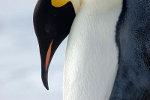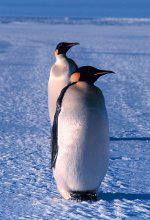 The Emperor Penguin is the largest species of penguin in the world and is natively found inhabiting the pack ice on and around the Antarctic continent. They are the most southerly breeding penguins and unlike other species, they spend their whole lives in the deep south.
The Emperor Penguin is the largest species of penguin in the world and is natively found inhabiting the pack ice on and around the Antarctic continent. They are the most southerly breeding penguins and unlike other species, they spend their whole lives in the deep south.Emperor Penguins are also unique amongst penguins as instead of breeding in the warmer summer months, eggs are laid at the beginning of the bitter winter, with the males left to face the freezing cold and strong winds for two months whilst incubating their eggs.

Until recently, there were estimated to be up to 350,000 individuals on and around the Antarctic continent. However, a recent study conducted by the UK, USA and Australia has shown that numbers are actually higher, with 595,000 Emperor Penguins having been recorded.


